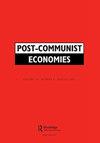Human capital and economic growth in Central Asia
IF 1.8
3区 经济学
Q2 ECONOMICS
引用次数: 0
Abstract
ABSTRACT This study explores the long-term economic performance in former Soviet republics of Central Asia for the last three decades. We look at sources of economic growth based on the extended version of the neoclassical growth model. Our key focus is to see whether human capital in the form of education and health inputs has an impact on growth rates in the region. Results show that over the entire period under study, on average, the growth rates of total factor productivity (TFP) were not remarkable, ranging from 1.4% for Kazakhstan and 0.51% for Tajikistan to −1.13% for the Kyrgyz Republic. Kazakhstan as a frontier economy of the region maintained better economic results in almost all indicators. Since 2000, TFP growth rates were notably stronger in Tajikistan compared to Kazakhstan and the Kyrgyz Republic. However, a reduction in TFP in Tajikistan in the 1990s is attributed to the country’s dire civil war.中亚地区人力资本与经济增长
摘要本研究探讨了中亚前苏联加盟共和国过去三十年的长期经济表现。我们根据新古典增长模型的扩展版本来研究经济增长的来源。我们的重点是观察以教育和卫生投入形式的人力资本是否对该区域的增长率产生影响。结果表明,在整个研究期间,全要素生产率(TFP)的平均增长率并不显著,从哈萨克斯坦的1.4%和塔吉克斯坦的0.51%到吉尔吉斯共和国的- 1.13%不等。哈萨克斯坦作为区域前沿经济体,在几乎所有指标上都保持了较好的经济成果。自2000年以来,塔吉克斯坦的全要素生产率增长率明显高于哈萨克斯坦和吉尔吉斯共和国。然而,上世纪90年代塔吉克斯坦全要素生产率的下降是由于该国可怕的内战。
本文章由计算机程序翻译,如有差异,请以英文原文为准。
求助全文
约1分钟内获得全文
求助全文
来源期刊

Post-Communist Economies
ECONOMICS-
CiteScore
4.90
自引率
18.20%
发文量
21
期刊介绍:
Post-Communist Economies publishes key research and policy articles in the analysis of post-communist economies. The basic transformation in the past two decades through stabilisation, liberalisation and privatisation has been completed in virtually all of the former communist countries, but despite the dramatic changes that have taken place, the post-communist economies still form a clearly identifiable group, distinguished by the impact of the years of communist rule. Post-communist economies still present distinctive problems that make them a particular focus of research.
 求助内容:
求助内容: 应助结果提醒方式:
应助结果提醒方式:


